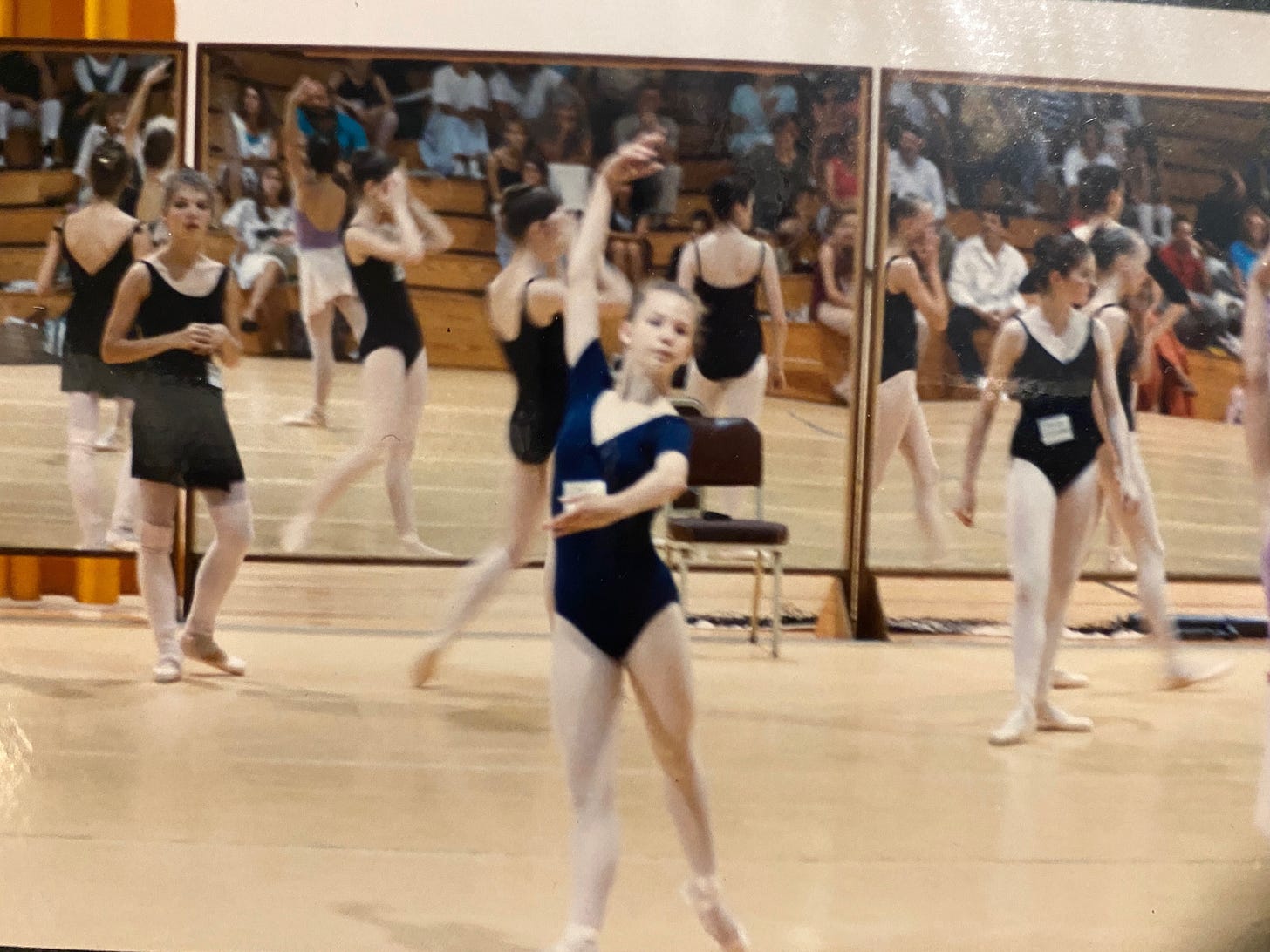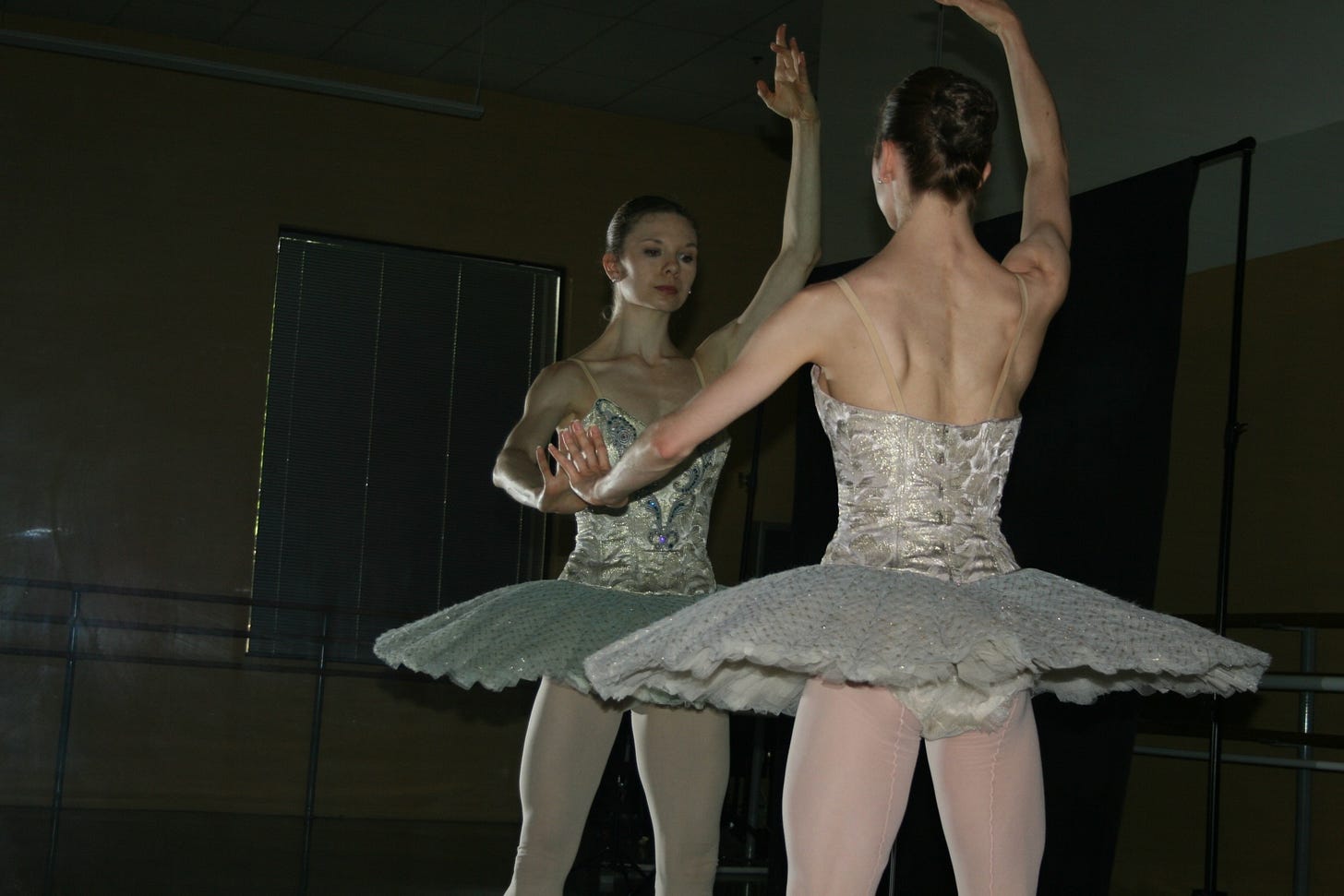One morning last week, a middle-aged woman (how did she get to be middle-aged? It seems to have snuck up on her. She feels the same inside as she did at 8, 12, 16, 22, 35… but all of a sudden she is three-quarters of the way through her golden anniversary year, has crepe-y skin and adult responsibilities, along with a nervous eye on her IRA) stepped out of the front door of her second-story apartment. Her door opened onto a petite, private porch with a canopy of leafy tree branches that are pretty overgrown, so she ducked her head on the way down the staircase to the driveway. She walked in between the two cars parked there, hers and her downstairs neighbors’, down to the sidewalk, and hung a right. She’d take Blair Street to Charlotte Street, an non-intuitive route to the main drag, so as to bypass the house of a neighbor that she wanted to avoid seeing or being seen by, but that’s another story.
You’ve heard me go on about the impactful, thought-provoking, and amazingly on-point podcast Hidden Brain. Last week, I heard an episode titled “Doing It The Hard Way,” which could describe the life of a ballet dancer— or that of many others who pursue physically and emotionally challenging careers. The host and guest on the podcast discuss how humans are wired to actually WANT to do hard, effortful things— they explain, with some powerful examples, our innate sense that the payoff of such a life may likely be greater and longer lasting than the steep investment. That’s ballet for ya. Non-dancing observers commonly wonder why we ballet dancers push ourselves through seemingly nutty ordeals— wearing pointe shoes, spending hours and years on intricate, painstakingly precise technical training, managing constant injury, aches and pains— all for what? Applause? No, because applause fades in seconds and is not an honest barometer of an audience’s appreciation anyway.
It was a beautiful morning. Later it would get hot, but even though it wasn’t that early— about 9:30— the air was cool, fresh, delightfully sweet, calm and welcoming. The neighborhood was equally calm, seeming to be just waking up, although, again, it was already mid-morning. The South Coast Seafood truck was blocking the bike lane on Charlotte Street, unloading its delivery to an upscale fish restaurant. The woman liked to peer in the open back of the truck at the boxes, labelled “FRESH FISH”, “KEEP COLD,” “ONIONS,” etc.
She paused at the pedestrian crossing (she never tapped the sensor to activate the flashing light signal, a holdover aversion from Covid days), but there were no cars coming from either direction so it was safe. Across Charlotte, the taqueria was just opening for the day. Just looking at that place takes you to Mexico. Blue tile roof, white siding, covered patio with picnic tables, wide open space on all sides, mariachi music piped out at just the right volume. The smell of roasting peppers and masa harina. Sun-baked asphalt. Huge blue sky. Just one customer was there so far today, a guy sitting in the shade at a picnic table with a breakfast burrito and his phone.
The exact nature of the payoff for needless hard work differs for everyone, and it comes in waves and degrees. But the commonality, I think, is the accomplishment one feels. These words that I heard on the podcast ring in my ears: Hard effort allows you to be the hero in your own life. You know you did something challenging, out of your comfort zone as they say, momentarily unpleasant, probably physically or emotionally uncomfortable. But friction is necessary. Contrast is necessary. Pleasure— lying on the beach all day, being waited on hand and foot, sinking into a couch, letting your body completely sag and relax— loses its pleasurability without a foil.
The woman, as usual, took a shortcut across the huge empty parking lot next to the taqueria to get to Chestnut Street. From Chestnut, it was a straight shot to the ballet studio. This is the point on her commute when she started thinking about the classes she was about to teach. She’d been thinking about them off and on all morning, but now is when she solidified her plans for each class, quizzed herself on the exercises she’d be giving, thought about alternatives if things didn’t seem to go well. This was also the point when she’d fix her gaze on the tiptop of a certain tree across the parking lot that had three distinct branch-tops poking up to the sky, and calculate how many hours it’d be until she’d retrace these same steps, but going the other direction, with work under her belt and home on the horizon.
I once had a conversation with a recently retired dancer who’d had a rather up-and-down ballet career. I say “up-and-down” because she kept hitting roadblocks the entire time— hers wasn’t a story of hard work, devotion, talent and a linear payoff. She was dogged and diligent, but couldn’t easily find the her place in the ballet world. She switched companies several times— usually not by choice— and even when she did settle into what became her “home” company, she couldn’t find a sense of security, of having arrived. But finally, she had her apex moment, her time of full realization. A choreographer came to stage a ballet on her company, Atlanta Ballet, and selected Olivia to dance a prominent role. She wasn’t used to being picked for the spotlight, which had contributed to the nagging insecurity she felt about her worth and purpose. Did her inner drive and compulsion to dance matter? Was her ambition leading her astray? When this choreographer began working with Olivia on the role, though, she felt something brand new— the thrilling mix of potential, achievability, and confidence that was ignited by his trust and belief in her powers. As Olivia put it, the choreographer set high expectations but also assumed and believed that she could meet them. “I felt very capable,” Olivia said. “I had never before been so in control of my body and my dancing. That experience showed me that when people expect hard things from me, I am able to rise to the occasion.”
She concluded, looking back on all the times her hard work and efforts were met with yet another ‘no,’ that it was all more than worth it. In fact, every wall she hit up against she later saw as a friend. “I was always struggling to attain the next thing I wanted. I’m proud that I didn’t give up, and that I kept going, and working, and asking, until the no turned into the yes that I wanted.”
It's about a fifteen minute walk to the ballet studio, just shy of a mile. In another bit of evidence of her middle-aged-ness, on that particular day the woman was eleven weeks post-op from her second hip replacement surgery. As a former professional dancer, arthritis had set in earlier than it might have for most, but she also had her dancer’s mentality— and stubbornness— going for her. Although walking was still hard and she could have taken the easy way (by car) to work, she resisted. Her inner rhythm wanted to trot, but her leg wanted to saunter. Class time was quickly approaching, and she felt trapped between her energy level (high) and her leg’s sluggishness.
With her class combinations set in her mind, and satisfied that she’d remember them when she was mid-performance in the studio, leading her classes, the woman’s thoughts turned to who would be there today. The students would all be kids, of course, ranging in age from as young as ten to late teens. Three classes today, two technique and one pointe. It was day three of the summer intensive. The kids’ schedule was packed— they were at the studio for up to seven hours each day— and the woman reminded herself not to push them too hard.
She got to the corner where Chestnut Street meets four other streets, the intersection appropriately known as “Five Points,” that was anchored by the ballet school and a diner, also called “Five Points.” She sometimes thought the ballet school should rename itself “Five Pointes,” just for kicks.
Just as she liked to peer into the back of the fish truck, the woman always cast a glance over to the diner when she passed by. It was very popular and always busy. She could hear the clatter of dishes from across the street and smell the universal olfactory signals of a diner— hash browns, toast, bacon, maple syrup. She couldn’t see inside, but she enjoyed picturing all the folks sitting at the counter or in the booths, having breakfast, drinking their coffee, the short order cooks at the grill, flipping pancakes and masterfully pulling together multiple orders at once.
Time to head inside. It’s gotten warmer in just the short time since she set out. She’ll be indoors, sealed up in air conditioning, for hours, so she took a few final deep inhalations of the glorious summer air, pulled open the studio door, and stepped over the askew floor mat. Kids were in both studios, lounging around, chattering, stretching, wearing various bits of ballet attire and street clothes. The woman was taken back, momentarily, to her own ballet-student days, when she’d done summer programs, too. Back then, she thought there was nothing better than spending every single day doing ballet. All day long. Leotard and tights over sweaty skin, that deliciously exhausted feeling in her muscles at the end of the day, emerging into the late afternoon air and hot sun on its way down, maybe (if she was at sleep away dance camp) a trip to the lake or a pool.
She walked to the back office, where her two co-workers were already setting down their things, sipping their coffees, and chatting about the day ahead. While she changed from her sneakers into her teaching shoes, the three talked about who had which class that morning, which variations they’d set on which level, which kid was being a bit of a pill and who should be moved up or left where they were. They debated how to respond to someone’s mom’s email, put their phones on Do Not Disturb, and with veiled reluctance, parted ways to the studios where their students were waiting.
Level B technique was the woman’s first class of the day. The 11, 12, and 13-year olds in the class had varied degrees of talent, ability, strength, physical attributes, and interest. The studio’s air conditioning wasn’t on very high, but by mid-way through barre, even the woman herself, who was always cold, felt it was stuffy. None of the students complained about the air, but she turned the temp down a few degrees anyway and zipped up her fleece sweatshirt. These youngsters were midway through their week and also, in the bigger scheme of things, approaching something of a midway point in their training. This was the age about when it become apparent who was really “into” ballet and who was ambivalent or enduring classes for the excitement of performances a couple of times a year. With some pride— and relief— she thought to herself that she’d trained these girls (there weren’t any boys in this class) pretty well. They had great classroom habits: doing the combinations full out while she or any teacher explained them, working on corrections even the teacher’s eyes were elsewhere, picking up the exercises quickly and accurately, and taking corrections with an attitude of interest and excitement, rather than feeling wounded by criticism. Although they had varying levels of ability to do so, they all knew without fail to keep straight legs, correctly pointed feet, tight tummies, lifted elbows, and turned out legs.
But. It was still summer, these children were young, had just put in two long days, and had been urged over and over to put 100% of their energy into everything all the time. The woman paused. She had just set a new combination and was about to tap 'play’ on the musical track on her phone. “How are you all doing?” she asked the class. “Are you tired?”
Most of the students just stood there without responding, but little Connie, one of the brightest and also the boldest, piped up as if she’d been previously appointed spokeswoman for the class. The brightness of her eyes and the expression on her face were as priceless as her words. “Yes, tired… but working hard!”
When I was dancing, I don’t want to say the best part was going home at night 🤣, but my sense of accomplishment after a show— no matter how well or not well it went— gave me a feeling of validity, assurance, and yes, confidence in my purpose and my ability to go forward— to the next day, the next ballet, the next phase of life. That is what I saw little Connie starting to understand last week. That’s why ballet matters. That’s why it’s so great for anyone to do, whether you end up on stage or not. “Accomplishment is generalized,” I heard on Hidden Brain. Accomplish something in one area of your day or life, and you carry that deep, quiet inner pride and self-worth to anything else you may face. You don’t need external validation when you’ve built it into your own body.
Find Gavin’s memoir, Being a Ballerina: The Power and Perfection of a Dancing Life, online at https://upf.com/book.asp?id=9780813066899 or anywhere books are sold.













Well, that was an interesting presentation. I totally appreciate that the "process" is the "goal". Thank you.